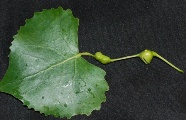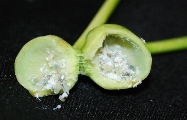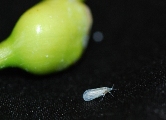Poplar Petiole Gall Aphid
Many samples of poplar or cottonwood leaves have come in lately with large, round bumps on the petioles of the leaves or perhaps at the very base of the leaf. These are often associated with the leaves falling from the tree itself to the ground and occasionally in substantial numbers.
The round bumps are called galls and are caused, in this case, by a particular aphid species, Pemphigus populitransversus, or the poplar petiole gall aphid. The gall itself contains many aphid that will leave the gall when mature. Essentially the gall is a house for the immature aphids to grow up in. This aphid overwinters in the egg stage on cottonwood or poplar twigs. In spring, the eggs hatch about the same time as the flushing of the foliage. The nymphs, or juvenile aphids, feed on the developing petioles, stimulating the formation of a hollow, round or oval gall. The aphids secrete a white, waxy material which coats their body and the inside of the gall. They feed for about two weeks and the females bear live young that mature into winged aphids. These winged females will leave the gall through the slit that is apparent on the side of the gall and fly to an alternate host.

Slit in gall for aphids to exit from
The alternate hosts are in the Brassica family so typically mustard or canola. They spend the remainder of the summer on the alternate host before flying back to the trees in the fall to lay eggs that spend the winter. These aphids may cause some leaf drop and certainly are responsible for the formation of the interesting galls, but they do not do any lasting damage to the trees. The galls are impenetrable to insecticides so any applications of control measures will have no effect on the aphids at all. Some years, as in 2008, the populations are quite a bit larger and more noticeable, especially with the increased leaf drop. But they are nothing more than an interesting curiosity and do not cause any tree mortality.





